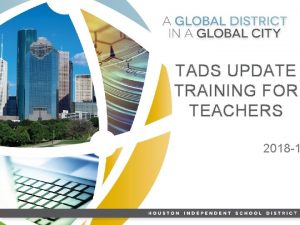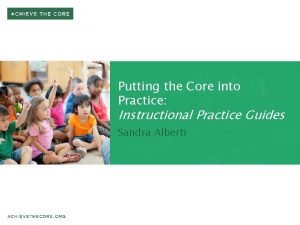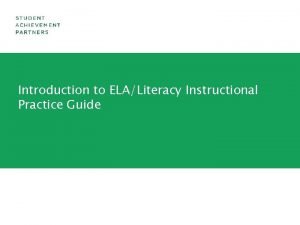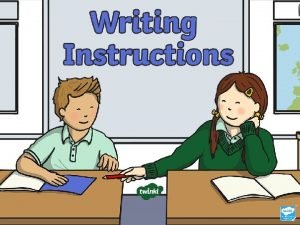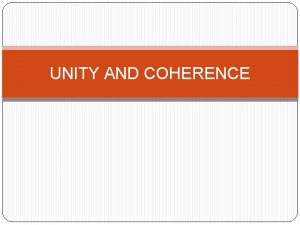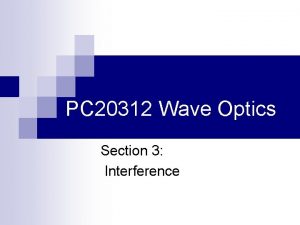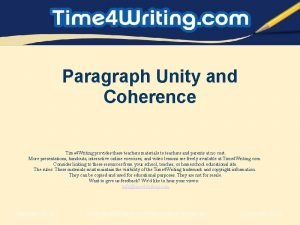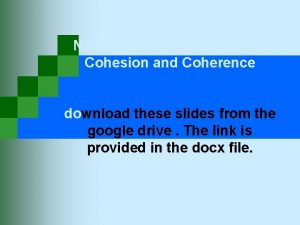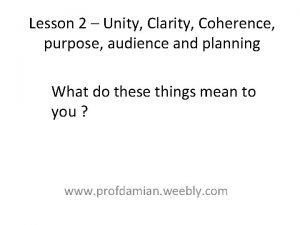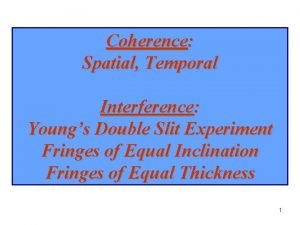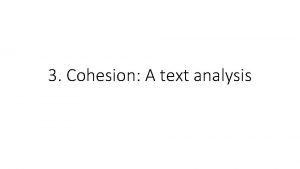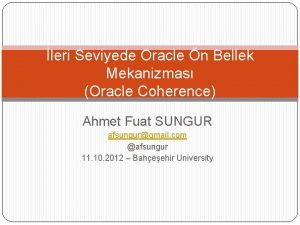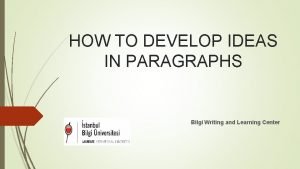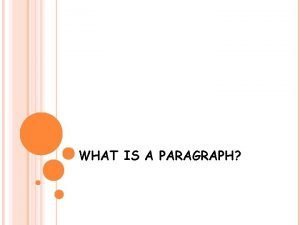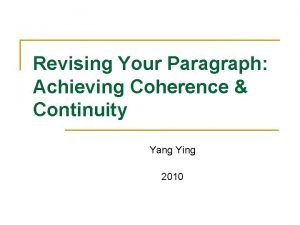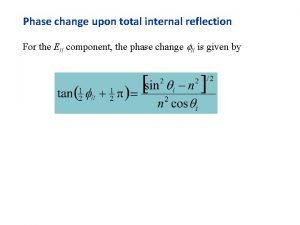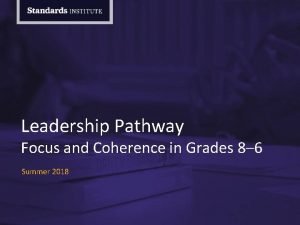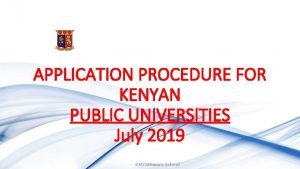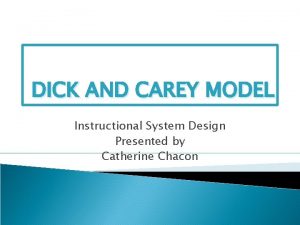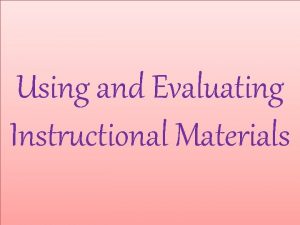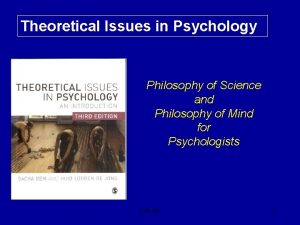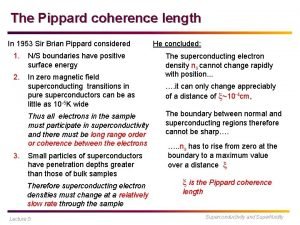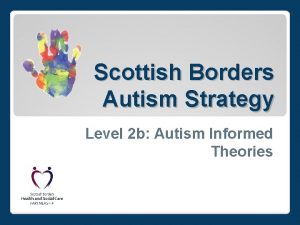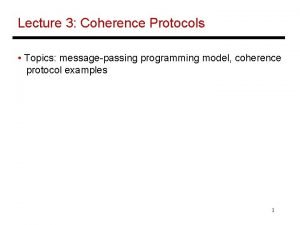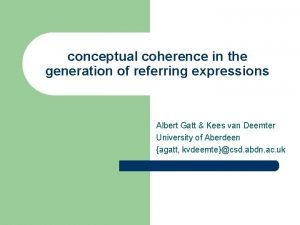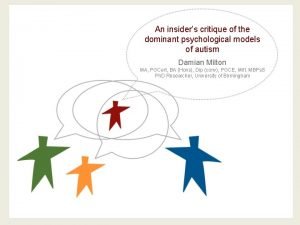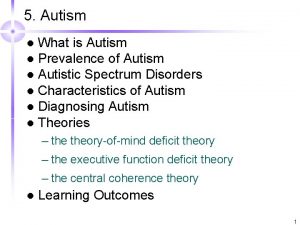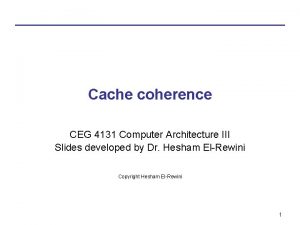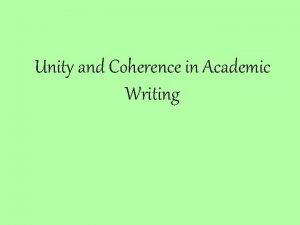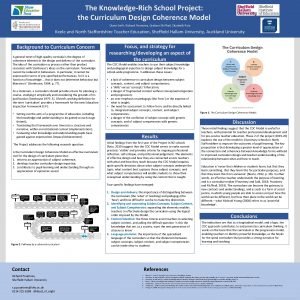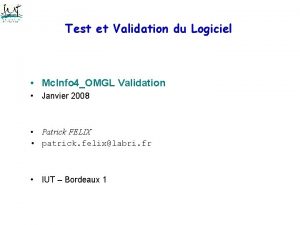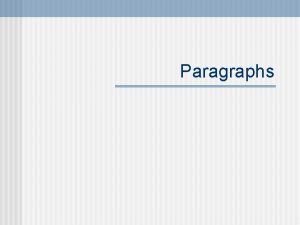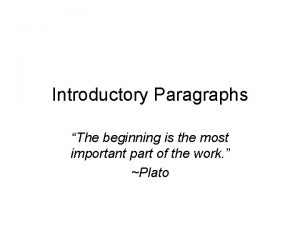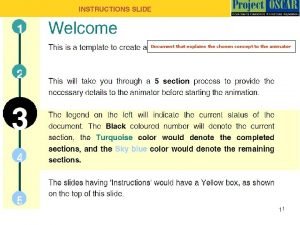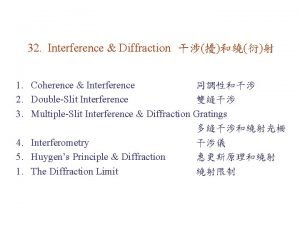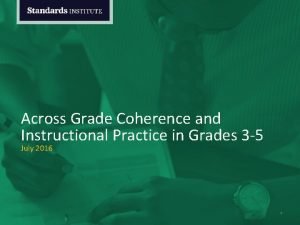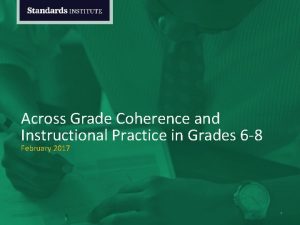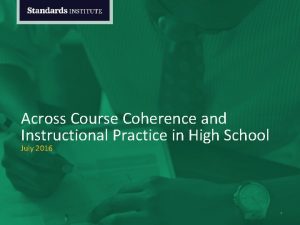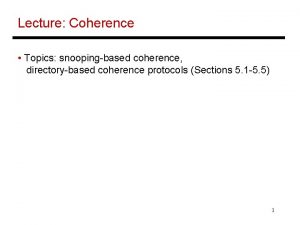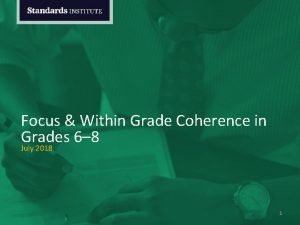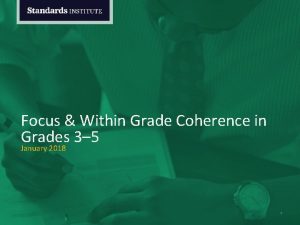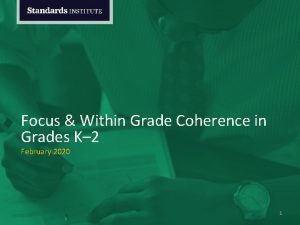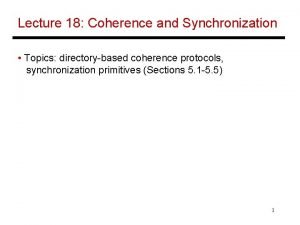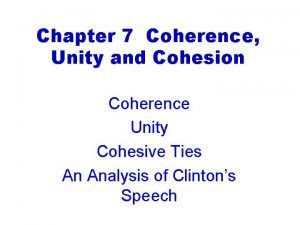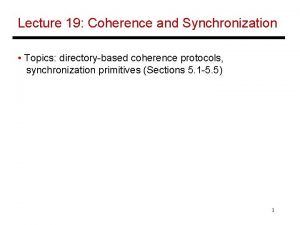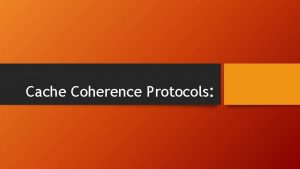Across Grade Coherence and Instructional Practice in Grades

































































- Slides: 65

Across Grade Coherence and Instructional Practice in Grades K– 2 January 2018 1

ACROSS GRADE COHERENCE IN GRADES K– 2 Welcome Back! 2

ACROSS GRADE COHERENCE IN GRADES K– 2 Thank You for Your Feedback! + 3

ACROSS GRADE COHERENCE IN GRADES K– 2 Norms That Support Our Learning • Take responsibility for yourself as a learner. • Honor timeframes (start, end, and activity). • Be an active and hands-on learner. • Use technology to enhance learning. • Strive for equity of voice. • Contribute to a learning environment in which it is “safe to not know. ” • Identify and reframe deficit thinking and speaking. 4

ACROSS GRADE COHERENCE IN GRADES K– 2 This Week Day Ideas Monday Focus and Within Grade Coherence Tuesday Wednesday Rigor and the Mathematical Practices Across Grade Coherence and Instructional Practice Thursday Adaptation and Curriculum Study Friday Adaptation and Practice “Do the math” Equity for all Connect to our practice 5

ACROSS GRADE COHERENCE IN GRADES K– 2 Today • Morning: Across Grade Coherence in Grades K– 2 • Afternoon: Instructional Practice in Grades K– 2 6

ACROSS GRADE COHERENCE IN GRADES K– 2 Morning Objectives • Participants will understand apply learning progressions to support students who are below grade level. o Participants will be able to identify a sequence of prerequisite standards necessary in math understanding and learning. o Participants will be able to identify onramps for teaching major work to students who are below grade level. o Participants will be able to adapt a lesson for students below grade level by adding just-in-time scaffolds based on learning progressions. o Participants will be able to explain how attending to the shift of across grade coherence is an equitable practice in Standards-aligned math instruction. 7

ACROSS GRADE COHERENCE IN GRADES K– 2 Morning Agenda I. Across Grade Coherence II. Vertical Coherence Challenge III. Mapping the Progressions IV. Tools for Understanding the Progressions V. Adapting Lessons for Students Below Grade Level 8

ACROSS GRADE COHERENCE IN GRADES K– 2 Equity • Equity is engaging in practices that meet students where they are and advances their learning by giving them what they need. It’s about fairness, not sameness. • Equity ensures that all children—regardless of circumstances—are receiving high-quality and Standards-aligned instruction with access to high-quality materials and resources. • We want to ensure that Standards-aligned instruction is a pathway to the equitable practices needed to close the gaps caused by systemic and systematic racism, bias, and poverty. • All week, we will explore our learning through an equity lens, and we will capture those moments visibly here in our room. 9

ACROSS GRADE COHERENCE IN GRADES K– 2 I. Across Grade Coherence How might a student explain that 10 + 6 is equal to 16? 10

ACROSS GRADE COHERENCE IN GRADES K– 2 What Is the Right Order? Grade K Compose and decompose numbers from 11 to 19 into ten ones and some further ones, e. g. , by using objects or drawings, and record each composition or decomposition by a drawing or equation (such as 18 = 10 + 8); understand that these numbers are composed of ten ones and one, two, three, four, five, six, seven, eight, or nine ones. Grade 2 Fluently add and subtract within 20 using mental strategies. …know from memory all sums of two one-digit numbers. Grade 1 Add and subtract within 20, demonstrating fluency for addition and subtraction within 10. Use strategies such as counting on; making ten (e. g. , 8 + 6 = 8 + 2 + 4 = 10 + 4 = 14); decomposing a number leading to a ten (e. g. , 13 – 4 = 13 – 1 = 10 – 1 = 9); using the relationship between addition and subtraction (e. g. , knowing that 8 + 4 = 12, one knows 12 – 8 = 4); and creating equivalent but easier or known sums (e. g. , adding 6 + 7 by creating the known equivalent 6 + 6 = 12 + 1 = 13). 11

ACROSS GRADE COHERENCE IN GRADES K– 2 Coherence Is Key “A focused, coherent progression of mathematics learning, with an emphasis on proficiency with key topics, should become the norm in elementary and middle school mathematics curricula. Any approach that continually revisits topics year after year without closure is to be avoided. By the term focused, the Panel means that curriculum must include (and engage with adequate depth) the most important topics underlying success in school algebra. By the term coherent, the Panel means that the curriculum is marked by effective, logical progressions from earlier, less sophisticated topics into later, more sophisticated ones. Improvements like those suggested in this report promise immediate positive results with minimal additional cost. ” –National Mathematics Advisory Panel 12

ACROSS GRADE COHERENCE IN GRADES K– 2 The Progressions 13

Across Grade Coherence: Learning is carefully connected across grades so that students can build new understanding onto foundations built in previous years.

ACROSS GRADE COHERENCE IN GRADES K– 2 II. Vertical Coherence Challenge • In your groups, you have 11 standards on pieces of paper. Most standards come from the Counting & Cardinality and Operations & Algebraic Thinking domains in Grades K– 2. • The standards are not labeled! • Determine which standards are prerequisites for other standards. • Note: There is more than one vertical strand. • Bonus: Can you determine which standards belong in which grade? 15

ACROSS GRADE COHERENCE IN GRADES K– 2 A Picture of Coherence Grade K Grade 1 Grade 2 Grade 3 and Beyond K. OA. A. 2 1. OA. A. 1 2. OA. A. 1 3. OA. D. 8 4. OA. A. 3 G I E C H K. CC. B. 4 c 1. OA. C. 5 1. OA. C. 6 2. OA. B. 2 2. NBT. B. 5 3. NBT. A. 3 K F A B J D 16

ACROSS GRADE COHERENCE IN GRADES K– 2 Progressions of Content How does understanding the progression of content support our understanding of grade-level content? 17

ACROSS GRADE COHERENCE IN GRADES K– 2 III. Standards Mapping Protocol: • Identify 3 prerequisite standards—the standards do not have to be in 3 different grades. • Identify the aspects of rigor for each prerequisite. The Standards: Grade K – K. NBT. A. 1 Grade 1 – 1. NBT. C. 4 Grade 2 – 2. NBT. B. 5 • Discuss with a partner: o How does each prerequisite support the standard? o Why is it important to pay attention to the rigor of the prerequisite standard? 18

ACROSS GRADE COHERENCE IN GRADES K– 2 Kindergarten—K. NBT. A. 1 Compose and decompose numbers from 11 to 19 into ten ones and some further ones, e. g. , by using objects or drawings, and record each composition or decomposition by a drawing or equation (such as 18 = 10 + 8); understand that these numbers are composed of ten ones and one, two, three, four, five, six, seven, eight, or nine ones. K. OA. A. 3 Decompose numbers less than or equal to 10 into pairs in more than one way, e. g. , by using objects or drawings, and record each decomposition by a drawing or equation (e. g. , 5 = 2 + 3 and 5 = 4 + 1). K. OA. A. 2 Solve addition and subtraction word problems, and add and subtract within 10, e. g. , by using objects or drawings to represent the problem. K. CC. B. 5 Count to answer "how many? " questions about as many as 20 things arranged in a line, a rectangular array, or a circle, or as many as 10 things in a scattered configuration; given a number from 1– 20, count out that many objects. 19

ACROSS GRADE COHERENCE IN GRADES K– 2 Grade 1— 1. NBT. C. 4 Add within 100, including adding a two-digit number and a one-digit number, and adding a two-digit number and a multiple of 10, using concrete models or drawings and strategies based on place value, properties of operations, and/or the relationship between addition and subtraction; relate the strategy to a written method and explain the reasoning used. Understand that in adding two-digit numbers, one adds tens and tens, ones and ones; and sometimes it is necessary to compose a ten. 1. NBT. B. 2 Understand that the two digits of a two-digit number represent amounts of tens and ones. Understand the following as special cases…. 1. OA. C. 6 Add and subtract within 20, demonstrating fluency for addition and subtraction within 10. Use strategies such as counting on; making ten (e. g. , 8 + 6 = 8 + 2 + 4 = 10 + 4 = 14); decomposing a number leading to a ten (e. g. , 13 - 4 = 13 - 1 = 10 - 1 = 9); using the relationship between addition and subtraction (e. g. , knowing that 8 + 4 = 12, one knows 12 - 8 = 4); and creating equivalent but easier or known sums (e. g. , adding 6 + 7 by creating the known equivalent 6 + 1 = 12 + 1 = 13). K. OA. A. 4 For any number from 1 to 9, find the number that makes 10 when added to the given number, e. g. , by using objects or drawings, and record the answer with a drawing or equation. 20

ACROSS GRADE COHERENCE IN GRADES K– 2 Grade 2— 2. NBT. B. 5 Fluently add and subtract within 100 using strategies based on place value, properties of operations, and/or the relationship between addition and subtraction. 1. NBT. C. 4 2. OA. B. 2 Fluently add and subtract within 20 using mental strategies. By end of Grade 2, know from memory all sums of two one-digit numbers. Add within 100, including adding a two-digit number and a one-digit number, and adding a two -digit number and a multiple of 10, using concrete models or drawings and strategies based on place value, properties of operations, and/or the relationship between addition and subtraction…. Understand that in adding two-digit numbers, one adds tens and tens, ones and ones…. 1. NBT. C. 6 Subtract multiples of 10 in the range 10– 90 from multiples of 10 in the range 10– 90 (positive or zero differences), using concrete models or drawings and strategies based on place value, properties of operations, and/or the relationship between addition and subtraction; relate the strategy to a written method and explain the reasoning used. 21

Break

ACROSS GRADE COHERENCE IN GRADES K– 2 IV. Understanding the Progressions Content Guides The Progressions Documents Wiring Diagram 23

ACROSS GRADE COHERENCE IN GRADES K– 2 Understanding the Progressions How does understanding the progressions support instruction? 24

How can we leverage Leveraging the Progressions progressions of content to give all students access to grade-level content? ACROSS GRADE COHERENCE IN GRADES K-2 25

ACROSS GRADE COHERENCE IN GRADES K– 2 V. Adapting Lessons for Students Below Grade Level Protocol: • Review Lesson 1 and identify the targeted standard. • Identify the prerequisite standards from prior grades that support the targeted standard. o What is the aspect of rigor for each prerequisite? • Discuss with a partner: o How does each prerequisite support the standard? o How could you strategically use these prerequisite standards to support students who are not on grade level? • Annotate the lesson with specific supports. • With your table: o Each pair shares out the specific adaptations you and your partner made. Explain why you made these adaptations. 26

ACROSS GRADE COHERENCE IN GRADES K– 2 Lesson Adaptations What types of adaptations could you consider at the lesson level? • Add a warm-up activity that connects to prior learning. • Add a section to the concept development portion to address prerequisite skills. • Replace one or more of the fluency activities to support understanding of prerequisites. 27

ACROSS GRADE COHERENCE IN GRADES K– 2 Adapting Lessons for Students Below Grade Level Protocol: time • 10 min: Individual work time • 15 min: Partner work • 10 min: Table share out Goals for This Activity: I. Review Lesson 1 and identify the targeted standard(s). II. What are the prerequisite standards from prior grades that support this standard(s)? III. What aspects of rigor are highlighted in the prerequisite standards? 28

Transition to Partner Time! 29

ACROSS GRADE COHERENCE IN GRADES K– 2 Adapting Lessons for Students Below Grade Level Protocol: • 10 min: Individual work time • 15 min: Partner work • 10 min: Table share out Goals for This Activity: I. How do these prerequisite standards support the grade-level standard(s)? II. How could you strategically use these prerequisite standards to support students who are not on grade level? o Annotate the lesson with specific supports. 30

Transition to Table Share! 31

ACROSS GRADE COHERENCE IN GRADES K– 2 Adapting Lessons for Students Below Grade Level Protocol: • 10 min: Individual work time • 15 min: Partner work • 10 min: Table share out Goals for This Activity: o Each pair shares out the specific adaptations made and explains why these adaptations were made. 32

ACROSS GRADE COHERENCE IN GRADES K– 2 Adapting Lessons for Students Below Grade Level What grade-level standard does the lesson address? What is the evidence of alignment to this standard? What are the prerequisite standards from prior grades that support this standard? Brainstorm ways you could use these prerequisites to support students below grade level with accessing the content of this lesson. • Annotate the lesson with specific supports. 33

ACROSS GRADE COHERENCE IN GRADES K– 2 Summary • What is the shift of coherence? • How does coherence help us support students below grade level? • How does rigor help us support students below grade level? 34

ACROSS GRADE COHERENCE IN GRADES K-2 Lunch 12: 00 -1: 00 Lunch 12: 00– 1: 00 35

INSTRUCTIONAL PRACTICE IN GRADES K– 2 Today • Morning: Across Grade Coherence in Grades K– 2 • Afternoon: Instructional Practice in Grades K– 2 36

INSTRUCTIONAL PRACTICE IN GRADES K– 2 Afternoon Objectives • Participants will be able to use the Instructional Practice Guide (IPG) as a lesson planning tool and a coaching tool. • Participants will be able to identify where, in lessons and videos, teachers engage in Core Actions. • Participants will be able to explain the relationship between Core Actions and equitable practices in Standards-aligned math instruction. 37

INSTRUCTIONAL PRACTICE IN GRADES K– 2 Afternoon Agenda I. Intro to the Instructional Practice Guide (IPG) II. Core Actions in Action! III. Lesson Planning with the IPG IV. Connect to Practice 38

INSTRUCTIONAL PRACTICE IN GRADES K-2 . . . effective teaching is the non-negotiable core that ensures that all students learn mathematics at high levels. . . Instructional Practice –Principles to Actions: Ensuring Mathematical Success for All (NCTM) 39

INSTRUCTIONAL PRACTICE IN GRADES K– 2 I. Instructional Practice Guide (IPG) The Instructional Practice Guide includes coaching and lesson planning tools to help teachers and those who support teachers to make the Key Shifts in instructional practice required by the Common Core State Standards (CCSS). 40

INSTRUCTIONAL PRACTICE IN GRADES K– 2 Core Actions 1. Ensure the work of the lesson reflects the Shifts required by the CCSS for Mathematics. 2. Employ instructional practices that allow all students to learn the content of the lesson. 3. Provide all students with opportunities to exhibit mathematical practices while engaging with the content of the lesson. 41

INSTRUCTIONAL PRACTICE IN GRADES K– 2 Core Action 1 Ensure the work of the lesson reflects the Shifts required by the CCSS for Mathematics. Indicators A. The lesson focuses on the depth of grade-level cluster(s), grade-level content standard(s), or part(s) thereof. B. The lesson intentionally relates new concepts to students’ prior skills and knowledge. C. The lesson intentionally targets the aspect(s) of rigor (conceptual understanding, procedural skill and fluency, application) called for by the standard(s) being addressed. 42

INSTRUCTIONAL PRACTICE IN GRADES K– 2 Core Action 2 Employ instructional practices that allow all students to learn the content of the lesson. Indicators A. The teacher makes the mathematics of the lesson explicit by using explanations, representations, and/or examples. B. The teacher provides opportunities for students to work with and practice grade-level problems and exercises. C. The teacher strengthens all students’ understanding of the content by sharing a variety of students’ representations and solution methods. D. The teacher deliberately checks for understanding throughout the lesson and adapts the lesson according to student understanding. E. The teacher facilitates the summary of the mathematics with references to student work and discussion in order to reinforce the purpose of the lesson. 43

INSTRUCTIONAL PRACTICE IN GRADES K– 2 Core Action 3 Provide all students with opportunities to exhibit mathematical practices while engaging with the content of the lesson. Indicators A. The teacher poses high-quality questions and problems that prompt students to share their developing thinking about the content of the lesson. Students share their developing thinking about the content of the lesson. B. The teacher encourages reasoning and problem solving by posing challenging problems that offer opportunities for productive struggle. Students persevere in solving problems in the face of initial difficulty. C. The teacher establishes a classroom culture in which students explain their thinking. Students elaborate with a second sentence (spontaneously or prompted by the teacher or another student) to explain their thinking and connect it to their first sentence. 44

INSTRUCTIONAL PRACTICE IN GRADES K– 2 Core Action 3—Indicators (cont’d) D. The teacher creates the conditions for student conversations where students are encouraged to talk about each other’s thinking. Students talk about and ask questions about each other’s thinking, in order to clarify or improve their own mathematical understanding. E. The teacher connects and develops students’ informal language to precise mathematical language appropriate to their grade. Students use precise mathematical language in their explanations and discussions. F. The teacher establishes a classroom culture in which students choose and use appropriate tools when solving a problem. Students use appropriate tools strategically when solving a problem. G. The teacher asks students to explain and justify work and provides feedback that helps students revise initial work. Student work includes revisions, especially revised explanations and justifications. 45

INSTRUCTIONAL PRACTICE IN GRADES K– 2 Deeper Dive with the IPG Small Group Protocol • Read the indicators of the Core Action for your group (pp. 5– 10). • Discuss the following with your small group: 1. How does this Core Action (including the indicators) support teachers and coaches in building understanding of Standards-aligned instruction? 2. What are the essential teacher practices that support the indicators? 3. How does this Core Action support equitable instruction for all students? 46

INSTRUCTIONAL PRACTICE IN GRADES K– 2 Deeper Dive with the IPG Table Discussion Protocol • Turn and teach. • Discuss the following with your table group: 1. How does this tool support teachers and coaches in building understanding of Standards-aligned instruction? 2. What are essential teacher practices that support each Core Action? 3. Where does each of the Standards for Mathematical Practice show up in the IPG? 4. How does this Core Action support equitable instruction for all students? 47

INSTRUCTIONAL PRACTICE IN GRADES K– 2 Deeper Dive with the IPG Whole Group Discussion Protocol 1. 2. 3. How does this tool support teachers and coaches in building understanding of Standards-aligned instruction? Where does each of the Standards for Mathematical Practice show up in the IPG? What connections did you make between the Core Actions and equitable instruction for all students? 48

INSTRUCTIONAL PRACTICE IN GRADES K– 2 IPG Summary • Useful in both planning and coaching • Evidence for the indicators can come from lesson materials, teacher actions, student discussion, and student work • When using as a coaching tool, not all indicators may be evident in a single class period • Not to be used as an evaluation instrument 49

INSTRUCTIONAL PRACTICE IN GRADES K– 2 II. Core Actions in Action! What Core Actions are visible? 50

Break

INSTRUCTIONAL PRACTICE IN GRADES K– 2 III. Lesson Planning with the IPG How can we use the Core Actions and indicators? • Planning • Evaluating • Reflecting 52

INSTRUCTIONAL PRACTICE IN GRADES K– 2 Lesson Planning The Core Actions should be evident in planning and observable in instruction. • • What parts of the lesson plan are vital to show evidence of Core Action 1? Annotate the lesson to show these. What are some of the things you could do to ensure alignment with the indicators for Core Actions 2 and 3? What to Review: Grade K, Module 1, Lesson 2 Grade 1, Module 1, Lesson 2 Grade 2, Module 1, Lesson 2 53

INSTRUCTIONAL PRACTICE IN GRADES K– 2 Example: Grade 2, Module 1, Lesson 3 54

INSTRUCTIONAL PRACTICE IN GRADES K– 2 Lesson Planning Goals for This Activity: Protocol: time • 15 min: Individual work time • 10 min: Small group collaboration • 15 min: Table share out 1. Read the lesson. 2. Annotate the lesson for your Core Action. • What parts of the lesson plan are vital to show evidence of Core Action 1? • What are some of the things you could do to ensure alignment with the indicators for Core Actions 2 and 3? 55

Transition to Small Group Time! 56

INSTRUCTIONAL PRACTICE IN GRADES K– 2 Lesson Planning Protocol: time • 15 min: Individual work time • 10 min: Small group collaboration • 15 min: Table share out Goals for this activity: 1. Share how you annotated the task with your group. 57

Transition to Table Share! 58

INSTRUCTIONAL PRACTICE IN GRADES K– 2 Lesson Planning Protocol: time • 15 min: Individual work time • 10 min: Small group collaboration • 15 min: Table share out Goals for This Activity: 1. Share your annotations with the people at your table. 2. Discuss and record: • What kinds of evidence supported the indicators for CA 1? • What kinds of actions did you add to support CA 2? • What kinds of actions did you add to support CA 3? 59

60

INSTRUCTIONAL PRACTICE IN GRADES K– 2 IV. Lesson Planning Protocol: Annotate your lesson for each Core Action: 1. What is the evidence of alignment to Core Action 1? How can you improve alignment to Core Action 1? 2. What are some of the things you could do to ensure alignment with the indicators for Core Action 2? 3. What are some of the things you could do to ensure alignment with the indicators for Core Action 3? 61

INSTRUCTIONAL PRACTICE IN GRADES K– 2 Summary • How will the Core Actions impact your work with creating and/or coaching around lesson plans, and ensuring equitable instruction for all students? • How has your thinking changed about lesson planning? • How have the Shifts impacted your approach to instruction? 62

Feedback Please fill out the survey located here: www. standardsinstitutes. org • Click “Winter 2018” on the top of the page. • Click “Details” on the center of the page. 49

INSTRUCTIONAL PRACTICE IN GRADES K– 2 Reference List Slide Source 12 Foundations for Success: The Final Report of the National Mathematics Advisory Panel, U. S. Department of Education: Washington, DC, 2008. http: //www 2. ed. gov/about/bdscomm/list/mathpanel/report/final-report. pdf 13 http: //math. arizona. edu/~ime/progressions/# 14 http: //www. corestandards. org/other-resources/key-shifts-in-mathematics/ 23 http: //math. arizona. edu/~ime/progressions/# http: //achievethecore. org/content/upload/ccssmgraph. pdf http: //achievethecore. org/coherence-map/ https: //www. unbounded. org/enhance_instruction? subjects=math 39 Principles to Actions: Ensuring Mathematical Success for All (NCTM) http: //www. nctm. org/Pt. A/ 40– 45 http: //achievethecore. org/category/1155/printable-versions 54 https: //www. engageny. org/resource/grade-2 -mathematics-module-1 -topic-b-lesson-3/file/92271 64

INSTRUCTIONAL PRACTICE IN GRADES K– 2 Image References Slide # Name and Photographer/Artist 2 "Welcome" by Josh Meek (Flickr) 10 “Students” by Jeff Peterson (Flickr). 14 “Skyscraper” by Japanexperterna. se (Flickr) 17 “Ladder” by Angie Harms (Flickr) 22 “muumuu coffee” by Ken Yamaguchi 25 “Underground” by Sergey Kochkarev (Flickr) 29, 56 "Transitions" by Arjan Almekinders (Flickr) 31, 58 “ 208/365 - He's got the whole world in his hands. ” by Courtney Carmody (Flickr) 35 “Lunch” by MIKI Yoshihito (Flickr) 39 “Clouds” by Alden Chadwick (Flickr) 50 “Binoculars” by Eric (Flickr) 51 “Aunty’s Almonds” by studio tdes (Flickr) 52 “mirrors” by Chris (Flickr) 60 “Share” by Got. Credit (Flickr) 65
 Tads hisd
Tads hisd Instructional practice guide
Instructional practice guide Ricas english language arts
Ricas english language arts Slidetodoc
Slidetodoc Practice assessor feedback examples
Practice assessor feedback examples Difference between coherence and unity
Difference between coherence and unity Unity coherence
Unity coherence What is temporal and spatial coherence
What is temporal and spatial coherence Paragraph unity
Paragraph unity What is unity paragraph
What is unity paragraph Coherent and cohesion meaning
Coherent and cohesion meaning Coherence and clarity
Coherence and clarity What is temporal and spatial coherence
What is temporal and spatial coherence V number in optical fiber
V number in optical fiber What is cohesion and coherence
What is cohesion and coherence Unity or sticking togetherness
Unity or sticking togetherness Verbal substitution examples
Verbal substitution examples Narrative coherence and fidelity examples
Narrative coherence and fidelity examples Narrative paradigm
Narrative paradigm Coherence oracle
Coherence oracle Unity and coherence
Unity and coherence Coherent vs incoherent scattering
Coherent vs incoherent scattering Paragraph examples
Paragraph examples Concluding sentence
Concluding sentence Cohesion and coherence
Cohesion and coherence Define coherence and cohesion
Define coherence and cohesion Logical connectors examples
Logical connectors examples Temporal and spatial coherence
Temporal and spatial coherence Focus and coherence
Focus and coherence Coherence and unity
Coherence and unity Kcse grading system
Kcse grading system Metamorphic facies
Metamorphic facies City and guilds walled garden
City and guilds walled garden Dick and carey instructional design
Dick and carey instructional design Communication technology meaning
Communication technology meaning øis
øis What are the steps in computing grades
What are the steps in computing grades Difference between grade a and grade aa eggs
Difference between grade a and grade aa eggs Meta - change morph -
Meta - change morph - Compare contrast transition words
Compare contrast transition words Coherence theory of truth
Coherence theory of truth Pippard coherence length
Pippard coherence length Central coherence theory autism
Central coherence theory autism Cache coherence protocols
Cache coherence protocols Madam rabia
Madam rabia Coherence explained
Coherence explained Coherence in waves
Coherence in waves Gpu cache coherence
Gpu cache coherence Central coherence theory autism
Central coherence theory autism Embedded figures test
Embedded figures test Cache coherence tutorial
Cache coherence tutorial Chained cache coherence protocol
Chained cache coherence protocol Unity in academic writing
Unity in academic writing Curriculum design coherence model
Curriculum design coherence model Cache coherence example
Cache coherence example Coherence in essay writing
Coherence in essay writing Cohérence info
Cohérence info Pgcps coherence framework
Pgcps coherence framework Coherence data grid
Coherence data grid Spatial coherence
Spatial coherence Edge emitting laser
Edge emitting laser Topic sentence and supporting details examples
Topic sentence and supporting details examples Seed paragraph
Seed paragraph Intrinsic coherence length formula
Intrinsic coherence length formula Coherence associates
Coherence associates Huygens principle example
Huygens principle example
